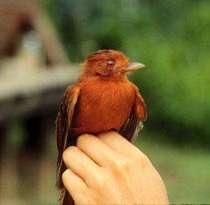Rufous Twistwing
It is associated with bamboo growing in humid forested regions in south-eastern Peru, northern Bolivia and far western Brazil . Most of its range is remote. Nevertheless, it has recently been estimated that the total population is below 10,000 individuals, leading to recommendations of treating it as vulnerable, and this was followed by BirdLife International in 2009. As suggested by its common name, its primaries are modified as in the related, but smaller, Brownish Twistwing. Unlike the Brownish Twistwing, the Rufous Twistwing is bright rufous overall.
The Rufous Twistwing is classified as Vulnerable (VU), considered to be facing a high risk of extinction in the wild.
The Rufous Twistwing (Cnipodectes superrufus) is a species of bird in the family Tyrannidae. It was described as a new species in 2007. It is associated with bamboo growing in humid forested regions in south-eastern Peru, northern Bolivia and far western Brazil (Acre only). Most of its range is remote. Nevertheless, it has recently been estimated that the total population is below 10,000 individuals, leading to recommendations of treating it as vulnerable, and this was followed by BirdLife International in 2009. More
The mystery of the Rufous Twistwing began in 1990, when Grace Servat captured and photographed a male in Manu National Park. Without a field guide or other reference material, the bird was left unidentified and prepared as a museum specimen until 2002 when Dan Lane found the skin in a museum tray in Lima, Peru, and realized it represented an undescribed species. Thus began a search for more information about this bird, resulting in its scientific description in 2007 (Lane et al. More
Twistwing, the Rufous Twistwing is bright rufous overall. References - Lane, D., G. P. Servat, T. Valqui H., & F. R. Lambert. 2007. A distinctive new species of Tyrant flycatcher from south-eastern Peru. Auk. 124(3): 762772. External links - Photo of the Rufous Twistwing - neomorphus.com Didn't find what you were looking for. More
- a Rufous Twistwing - has recently been formally described to science. It is neither rare nor difficult to find, yet it evaded discovery until very recently. How can that be? This article looks at the psychological and cultural factors that conspire to prevent birders and ornithologists from recognizing the obvious.* Read article. More
Rufous Twistwing vocalisation #2 Cnipodectes superrufus (0:34) Joseph Tobias XC40544 nov 2004, Bolivia Rufous Twistwing vocalisation #3 Cnipodectes superrufus (0:39) Joseph Tobias XC40545 nov 2004, Bolivia Rufous Twistwing call? Cnipodectes superrufus (0:28) Diego García Olaechea XC44574 23-01-2010, Peru page 1 © 2005-2010 Xeno-canto Foundation. More

Permission: Some rights reserved
Family : Tyrannidae
Genus : Cnipodectes
Species : superrufus
Authority : Lane, Servat, Valqui & Lambert, 2007
